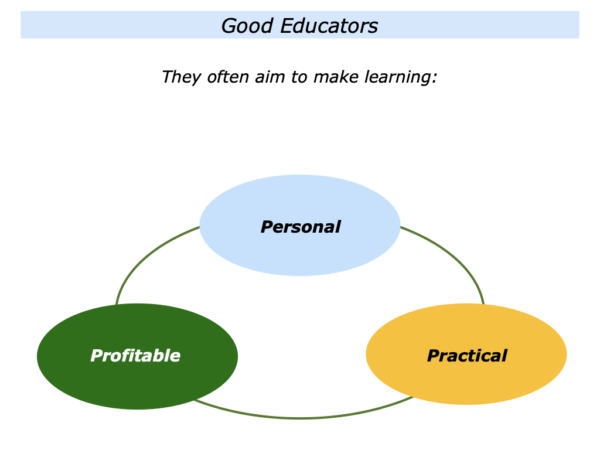
“The learner learns what the learner wants to learn,” we are told. Good educators often follow this approach when designing educational experiences. They aim to make the learning personal, practical and, in the widest sense, profitable.
Personal – It must relate to the person and their goals.
Practical – It must be practical and provide tools that help the person to reach their goals.
Profitable – It must be, in the widest sense, profitable and help the person to achieve their goals.
This is an approach that can be used when teaching, coaching, mentoring or running workshops. It aims to provide people with practical tools they can use to achieve their picture of success.
Looking back, when have you used some of these principles to help people to learn? You may have been helping a person to develop a skill, a team to tackle a challenge, a chief executive to build a successful organisation or whatever.
If you wish, try tackling the exercise on this theme. This invites you to do the following things.
Describe a specific time when you helped people – a person or a group – to learn something they found personal, practical and profitable.
Describe the specific things you did then to help them to learn something they found personal, practical and profitable.
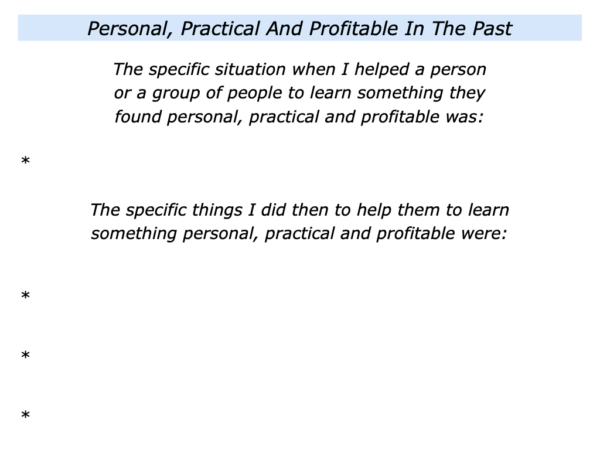
Making Learning Personal
People love to learn. They love to go through the process of absorption, adventure and achievement. They do, however, like the learning to relevant.
Today there are many educational projects that are helping young people to develop what are called Twenty First Century Skills. These are Critical Thinking, Collaboration, Creativity and Communication.
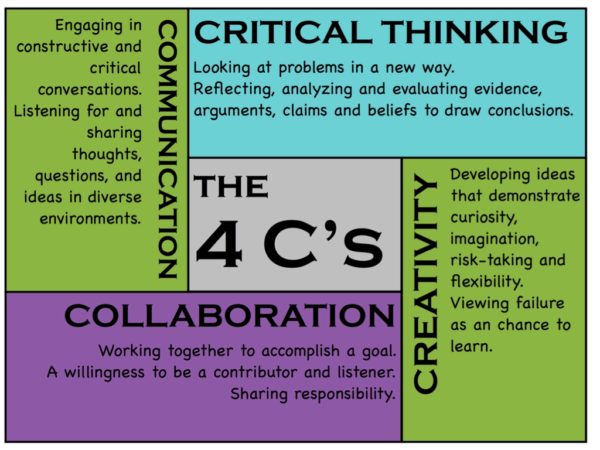
Young people need to learn the basic skills of reading, writing and arithmetic. They often learn best if they have good relationships with their educators, however, and see the relevance of what they are learning. They are then more likely to develop the rigour to deliver results.
Educators now talk about the importance of young people demonstrating grit. One key point to remember, however, is that different people show grit in different areas.
A person may demonstrate grit when learning how to assemble a motorbike, for example, but not when learning algebra. They are prepared to put in the grunt work when they feel it will contribute towards achieving the great work.
As people get older, they often become more selective about what they want learn. Adult learners, for example, want to learn things they see as relevant towards achieving their personal or professional goals. This highlights another key step in education.
Making Clear Working
Contracts With Individuals
Imagine a person has asked you to be their coach. You will begin by welcoming the person and creating an encouraging environment. It will then be useful to make clear contracts about what they want to get from the session.
In my own work, for example, I do a lot of coaching via Zoom. Before our first meeting I explain what I can help with and, sometimes just as importantly, what I can’t. Some of my work is with performing artists, so then I explain.
The topics I can help with include:
How to clarify your picture of success;
How to build on your strengths and manage the consequences of any weaknesses;
How to pursue practical strategies for achieving your goals;
How to find solutions to particular challenges you face in your personal or professional life;
How to continue to do your best to achieve your picture of success.
I can’t help them with technical things, such as how to be a better singer. What I can help with, however, are things like how to manage their emotions and be calm during performances. We then focus on what the person wants to explore and take away from the session.
Making Clear Working
Contracts With Teams
You will probably go through a similar contracting process when working with teams. Different people do this in different ways. One approach is to talk with the key stakeholders beforehand and ask some of the following questions.
What are the goals for the session? What are the key themes it would be useful to focus on? What are the concrete things that you and other people would like to take away from the session?
Who are the people who will be involved? What is happening in their world? What are some of the challenges they face? What are the specific results they want to deliver – or must deliver – in their work?
What are their strengths? What are the specific areas in which people deliver As, rather than Bs or Cs? How can they build on these strengths? What are the things they need to learn to manage the consequences of any weaknesses?
What for you would make it a successful session? What are the specific things you would like people to be saying, thinking, feeling and doing after the session? What are the steps they could take towards achieving their picture of success?
Bearing their answers in mind, play back your understanding regarding the goals for the session. Make sure everybody is agreed on the desired outcomes. When starting the team workshop, you can then say something like:
Welcome To The Session
Today the aim is to provide practical tools you can use to continue to build on your strengths, find solutions to challenges and achieve success.
Some of the topics we aim to explore today are:
How to …
How to …
How to …
My role is to provide an encouraging environment and practical tools that work. The role I would like you to take is to encourage each other and also apply the tools in your own way.
Bearing in mind what I have outlined, are there any other topics you would like us to explore?
If appropriate, you can also add other topics that will contribute towards the team achieving success. People often say, however:
“That sounds enough to be going on with. If we do those things, then we will be well on our way.”
Good educators make sure that the learning relates to people’s personal or professional goals. They then move on to the next stage.
Making Learning Practical
Good educators often focus on success. They also study how to find solutions to particular challenges.
They study what works, simplify what works – in a profound way – and share what works. They then provide people with practical tools they can use to follow these principles in their own way.
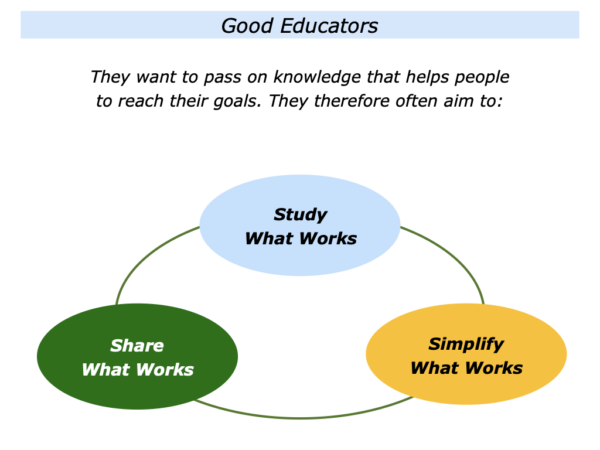
Great organisations, for example, implement the right strategy with the right people in the right way. This sounds simple, but it is vital to focus on what really works in practice. You can then help people to follow these steps and achieve their picture of success.
Different educators pass on this knowledge in different ways. Many focus on the Three Is: inspiration, implementation and integration.
They create an inspiring environment, provide implementation tools that work and help people to integrate the learning in their daily lives and work.
Good coaches, for example, often like to watch the person in action or see examples of their work. They then ask themselves.
What are the person’s goals? What are the real results they want to achieve? What is their picture of success?
What are they doing well? How can they follow these principles more in the future? What can the person do better and how? What are the skills they need to learn?
What are the key messages I therefore want to give them? What are the positive models and practical tools I can use to help them to achieve their goals? How can I pass on this knowledge in a way they can use to achieve their picture of success?
Different educators help people by passing on learning in different ways. Kiran Bir Sethi and her colleagues at the Riverside School in Ahmedabad, India, encourage their students to follow the design process of Feel, Imagine, Do, Share.
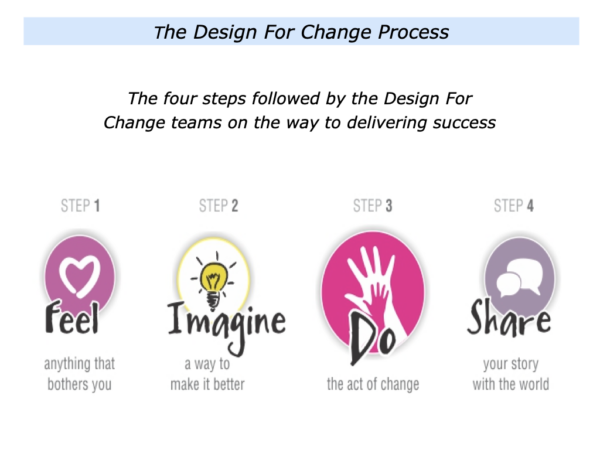
This became the basis for the Design For Change programme involving children around the world. Here is an introduction from the DFC website.
This year, Design for Change reaches 34 countries and over 300,000 schools inspiring hundreds of thousands of children, their teachers and parents, to celebrate the fact change is possible and that they can lead that change!
The challenge asks students to do four very simple things: Feel, Imagine, Do and Share.
Children are dreaming up and leading brilliant ideas all over the world, from challenging age-old superstitions in rural communities, to earning their own money to finance school computers to solving the problem of heavy school bags – children are proving that they have what it takes to be able to ‘design’ a future that is desired.
Making Learning Profitable
Good educators aim to make the learning, in the widest sense, profitable. You will have your own way of helping people to get tangible benefits.
One approach is to help them to go through the stages of awareness, application and achievement. Let’s explore how this works in practice.
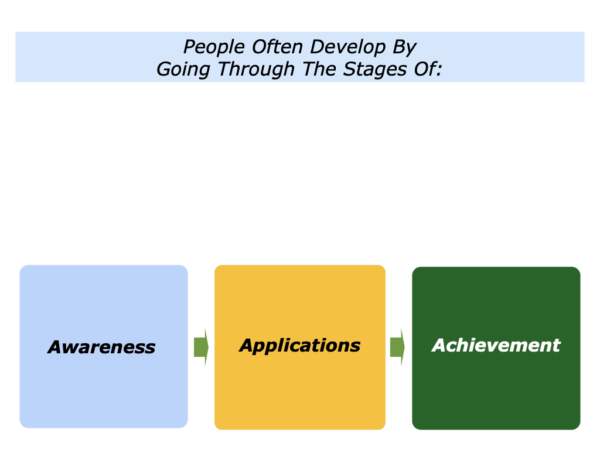
People start by clarifying the goal they want to achieve. They then raise their awareness about how to reach the goal. They gather information, learn from experts, study best practice or whatever.
Awareness is a good starting point, but it is vital to translate the ideas into action. People then apply the knowledge. They develop their skills and build on what works. They find solutions to challenges, reach their goals and gain a sense of achievement.
Some people, of course, become awareness junkies. They simply want to collect more ideas, but seldom translate these into action. This can lead to frustration, both for themselves and other people.
Many employers, for example, want their people to develop their awareness, but they actually pay for application and achievement. People who apply their learning – and who are persistent – are more likely to achieve their goals.
If you work in the coaching profession, for example, you may be judged by your ability to provide people with practical tools they can use to achieve success. One business leader expressed this sentiment in the following way.
“Many people are aware of the guiding principles for living an enjoyable life, leading a business or running successful teams.
“People can surf the web and see these principles repeated time and again. There are thousands of experts on organisations, for example, who want to market their latest idea.
“What leaders pay for, however, is application. They want people to be helped to apply the ideas in real life situations and deliver success.”
The process starts, however, by clarifying people’s goals. As we mentioned at the beginning:
“The learner learns what the learner wants to learn.”
Such an approach sounds sensible, but sometimes it is not translated into action. This was highlighted during a conversation I had with one of the world’s best coaches for goalkeepers in soccer.
He was hired by a famous club to work with a goalkeeper who had won several championships and the European Cup. The coach reported:
“Before the first session I asked him what he wanted to learn and how he wanted to develop as a goalkeeper. The reply was surprising.
“He said that, during his twenty years as a goalkeeper, no coach had ever asked him those questions. So we sat down together and came up with a development plan.
“The goalkeeper went on to extend his career and win even more trophies.”
Good educators encourage, educate and enable people to achieve ongoing success. You will, of course, do this in your own way.
If you wish, try tackling the exercise on this theme. This invites you to look to the future and do the following things.
Describe a situation where you may want to help a person or a group of people to develop by learning something they find personal, practical and profitable.
Describe the specific things you can do to help them to learn the thing they find personal, practical and profitable.
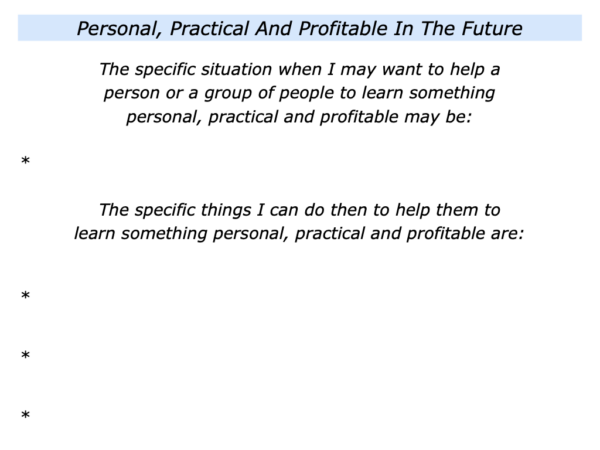


Leave a Reply